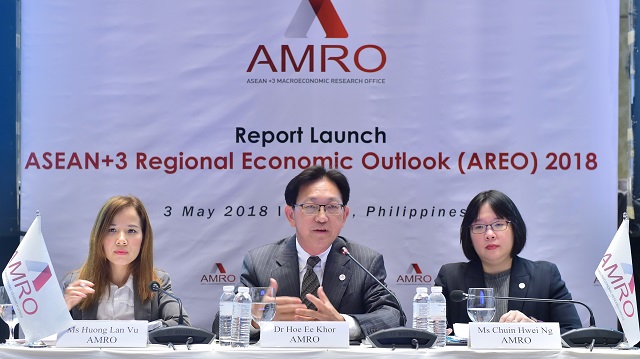 AMRO Chief Economist Dr Hoe Ee Khor (middle) delivers a presentation on the key findings of the ASEAN+3 Regional Economic Outlook (AREO) 2018 at the report launch on May 3, 2018, in Manila, Philippines.
AMRO Chief Economist Dr Hoe Ee Khor (middle) delivers a presentation on the key findings of the ASEAN+3 Regional Economic Outlook (AREO) 2018 at the report launch on May 3, 2018, in Manila, Philippines.
Also available in Bahasa Indonesia | Chinese | Japanese | Khmer | Korean | Lao | Malay | Myanmar | Thai | Vietnamese
The region should improve connectivity, grow a vibrant services sector, and develop a skilled labor force
MANILA, PHILIPPINES, May 3, 2018 – Boosted by favorable global conditions, economic growth in the ASEAN+3 region has been underpinned by resilient domestic demand and export growth, with stable inflation, says a new report released today by the ASEAN+3 Macroeconomic Research Office (AMRO).
As AMRO’s annual regional surveillance publication, the ASEAN+3 Regional Economic Outlook (AREO) assesses the regional economic outlook and financial stability in the region, which includes 10 members of the Association of Southeast Asian Nations and China, Hong Kong, China, Japan, and Korea. In this year’s edition, the report also includes a thematic study titled “Resilience and Growth in a Changing World”.
“With improving external demand, growth in the region is expected to be sustained at 5.4% for 2018 and 5.2% for 2019,” says AMRO Chief Economist Dr Hoe Ee Khor. “However, in view of the risks of tightening global financial conditions and trade protectionism, it would be prudent for policymakers to prioritize financial stability over the economic growth objective.”
Despite resilient domestic demand and stronger external demand for exports, the region is facing two near-term risks: faster-than-expected tightening in global financial conditions led by the U.S. Fed’s interest rate hikes and an escalation of global trade tensions. If these risks materialize, there would be spillovers to the region through capital outflows, higher borrowing costs, and lower trade and investment flows.
Improving external demand has allowed the region to build up buffers further against potential external shocks. Regional exchange rates have become more flexible in recent years, and have played a greater role as a shock absorber.
To enhance resilience, policymakers in the region should continue to build policy space, particularly in monetary policy, in anticipation of tighter global financial conditions ahead. Fiscal policy may have to play a greater role in supporting growth while macroprudential policy can help safeguard financial stability.
The AREO 2018 also contains a thematic study on how the region can maintain its resilience and growth in view of fundamental and global changes in technology and in trade and production networks. These global forces are putting the region’s “manufacturing for exports” growth strategy, which has spurred the region’s growth and development over the past decades, to the test.
Technology has proven to be a double-edged sword as manufacturing is becoming more capital and skills intensive and will no longer employ as much labor as in the past. Structural changes in global value chains have also allowed countries to produce domestically instead of importing intermediate inputs. However, technology has facilitated the emergence of the services sector as a potential new engine of growth and employment.
To address these challenges, the region as a whole should strengthen intra-regional connectivity and integration to leverage on growing intra-regional final demand and improve the resilience of the region as a whole against external shocks such as protectionism. Individual economies should build resilience through developing multiple engines of growth, including the growing services sector.
“The ample resources and diversity in development within the ASEAN+3 region are sources of strength,” says Dr Khor. “The region should improve connectivity through investment in infrastructure with trade facilitation policies, grow a vibrant services sector, and develop a skilled labor force through labor upskilling, immigration, and education.”
 More than 100 participants, including ASEAN+3 policymakers, journalists, academics, representatives from peer international organizations and the private sector, attend the AREO 2018 launch.
More than 100 participants, including ASEAN+3 policymakers, journalists, academics, representatives from peer international organizations and the private sector, attend the AREO 2018 launch.
—
About AMRO:
The ASEAN+3 Macroeconomic Research Office (AMRO) was established to contribute to securing the economic and financial stability of the ASEAN+3 region, which includes 10 members of the Association of Southeast Asian Nations (ASEAN); and China; Hong Kong, China; Japan; and Korea. As an international organization, AMRO fulfils its mandate by conducting macroeconomic surveillance, supporting the implementation of the regional financial arrangements, the Chiang Mai Initiative Multilateralisation (CMIM), and providing technical assistance to the members.
